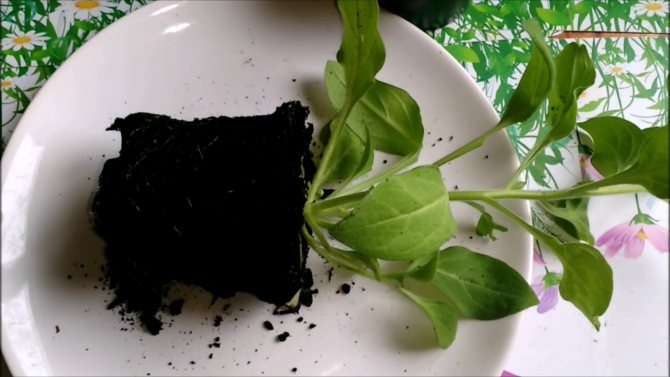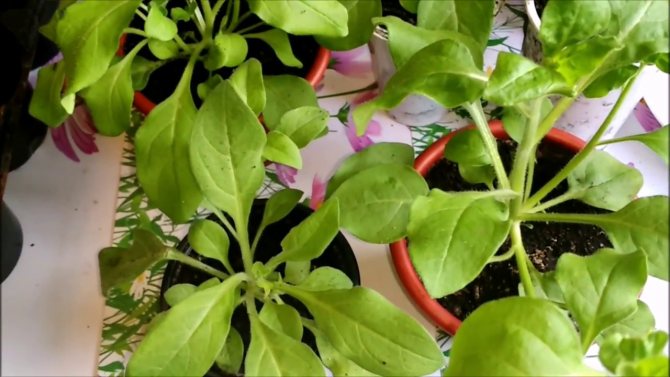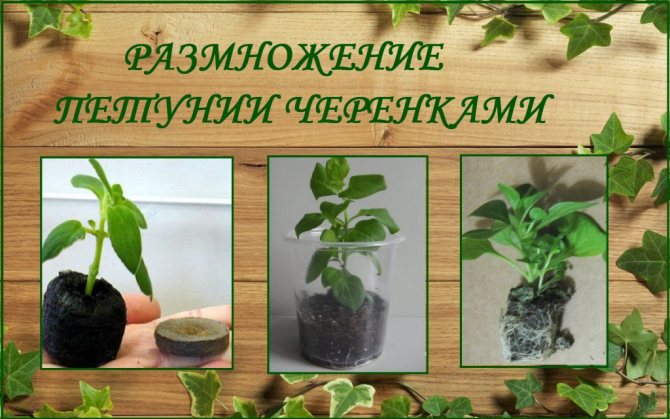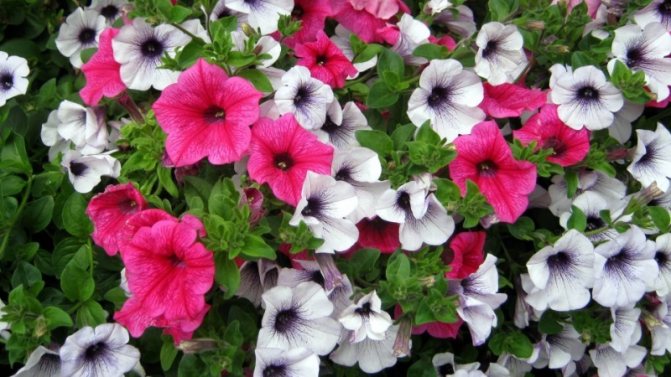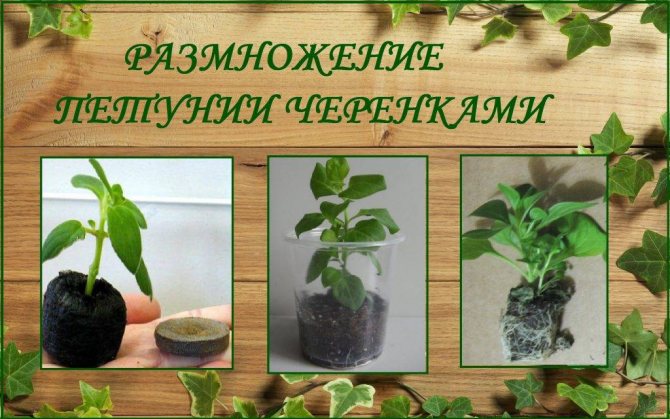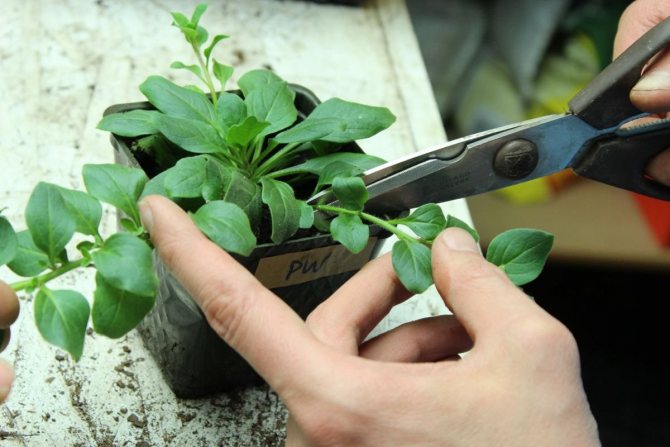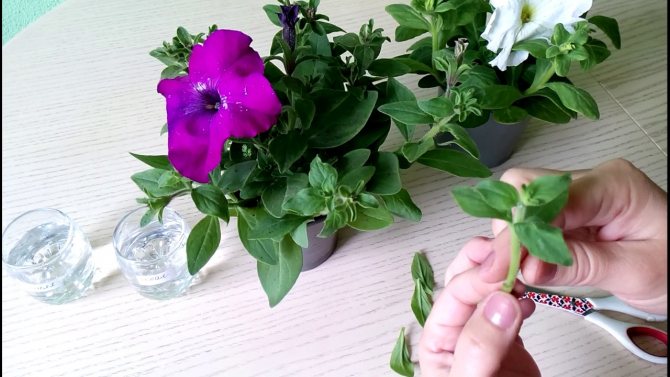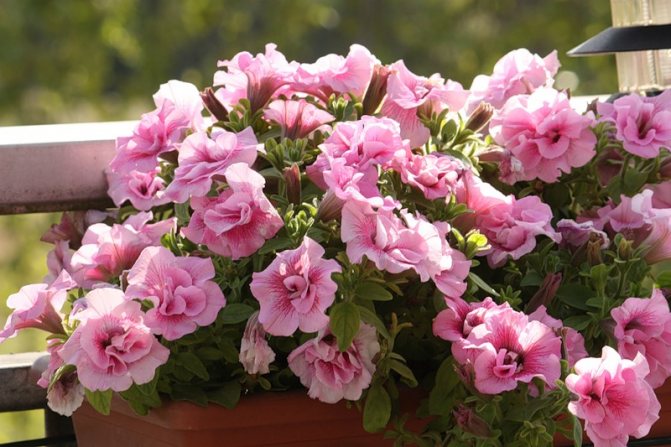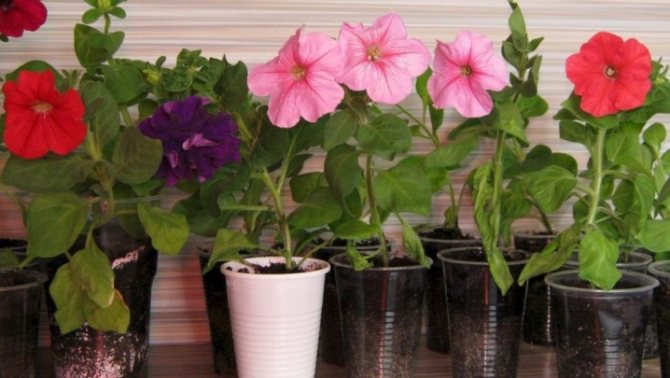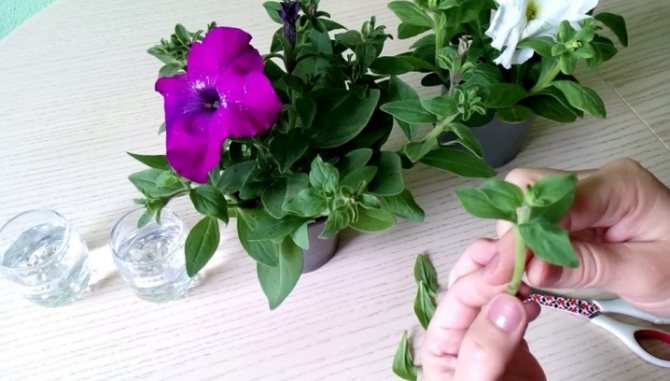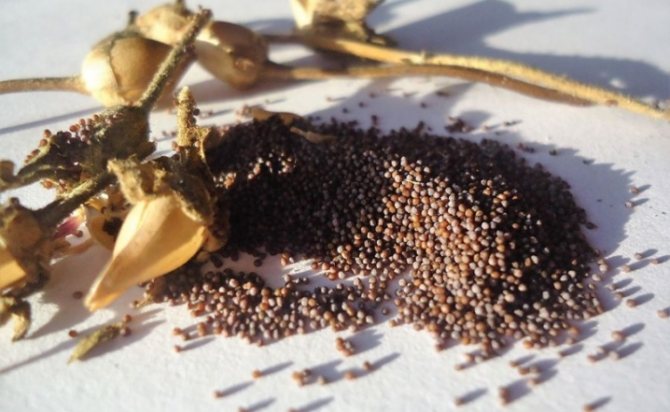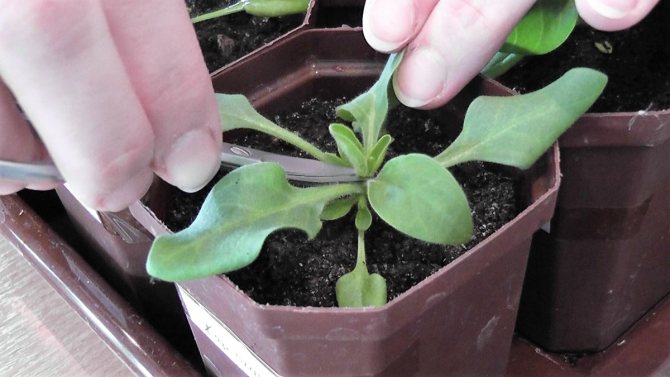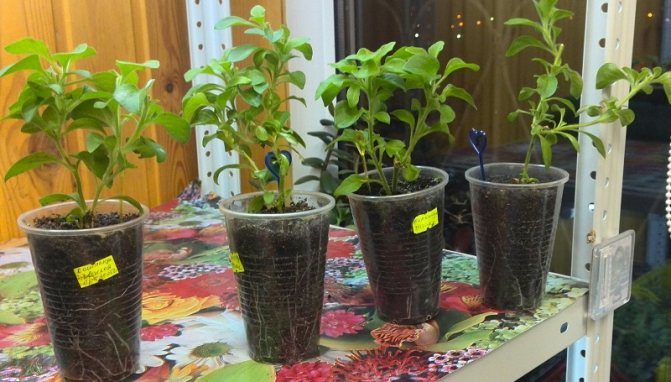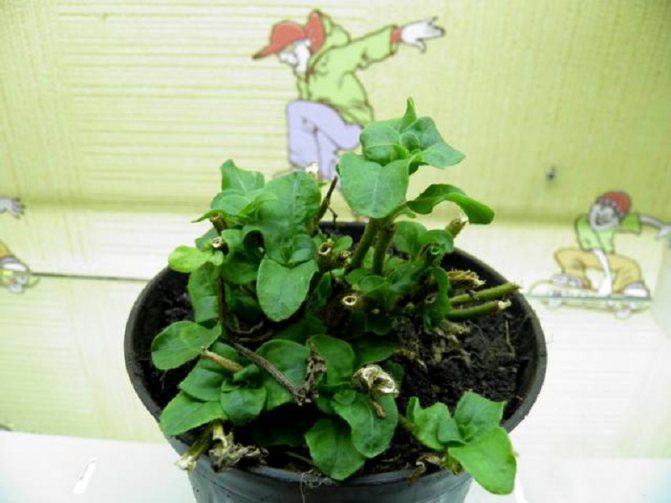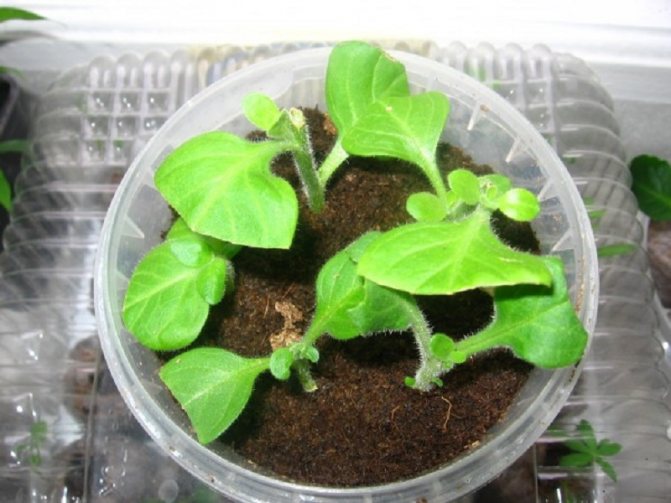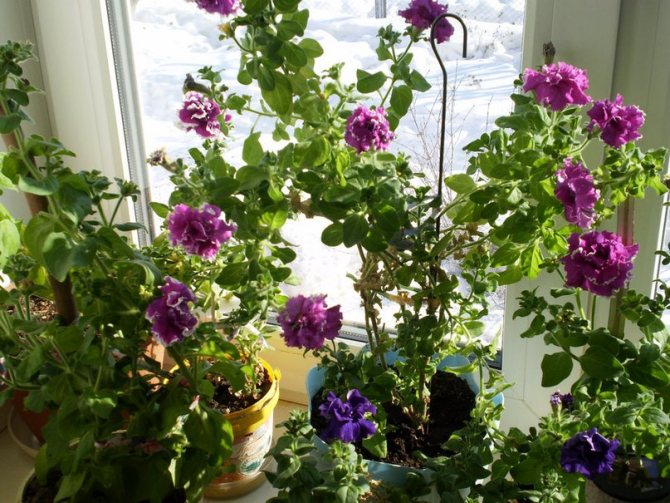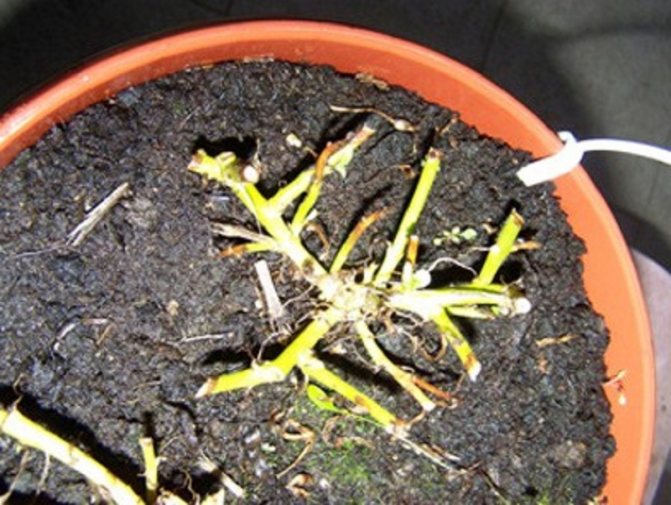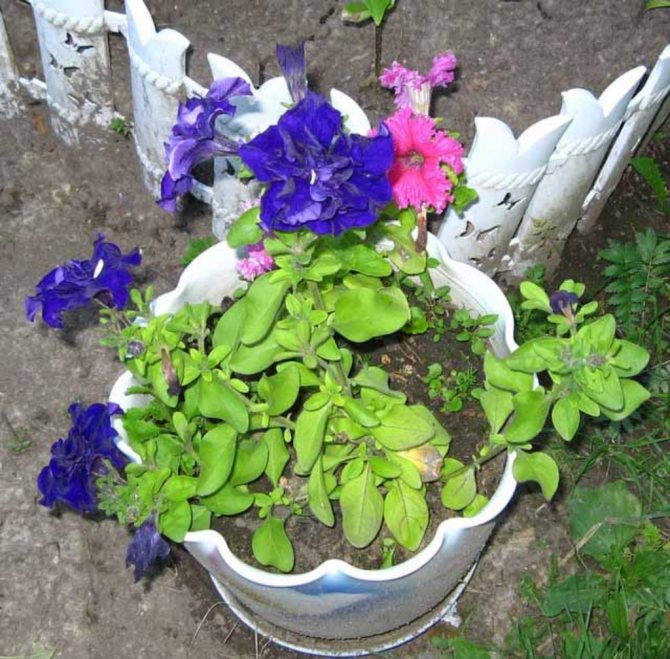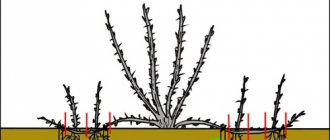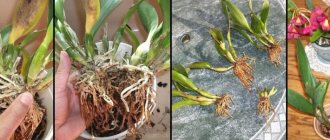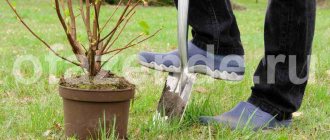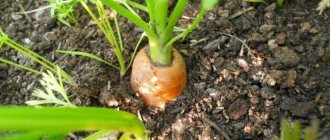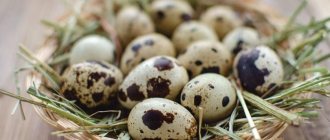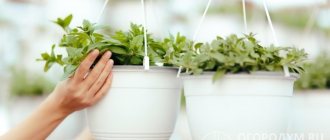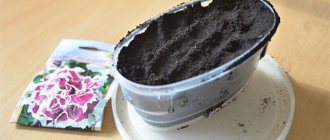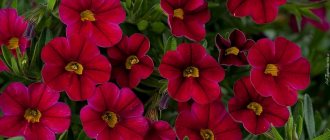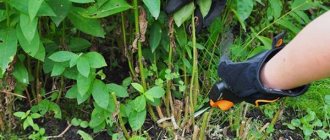Petunia is a beautiful, unpretentious plant that blooms from early spring to the very frost. Having bought planting material once, the culture is propagated an unlimited number of times by cuttings or seeds.
Most flower growers prefer cuttings, as it allows you to quickly get developed flowering seedlings, regardless of which mother plant is used - hybrid or varietal. The results of growing from seeds are unpredictable: the signs of a hybrid are rarely transmitted to the seeds, and the inflorescences are easily pollinated.
How to propagate petunia cuttings for the winter, read on.
Cutting petunias: benefits
Why is this method chosen when breeding petunias in the first place:
- the root system of such seedlings develops more rapidly;
- seedlings take root better during transplantation and are more resistant to open ground conditions;
- in comparison with petunias obtained from seeds, cuttings beauties bloom two weeks earlier;
- economically, in comparison with buying seedlings or seeds;
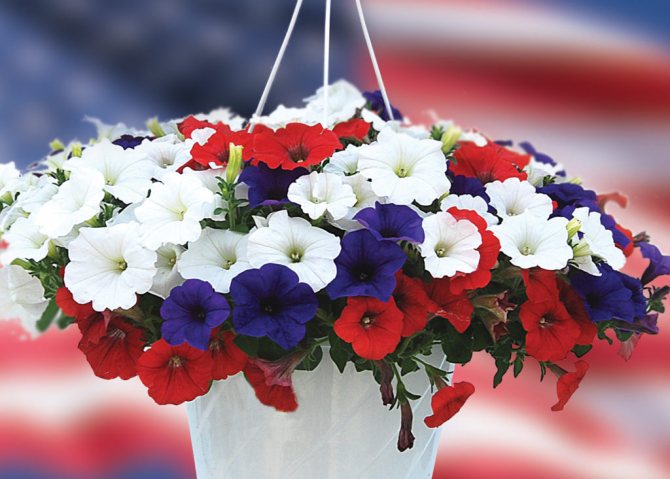
Petunia is capable of vegetative reproduction throughout the year.
- quickly - the time period from the first cut to the blooming of a new young bush is two months;
- even a novice florist can handle cuttings;
- this procedure does not require the use of special technique or equipment.
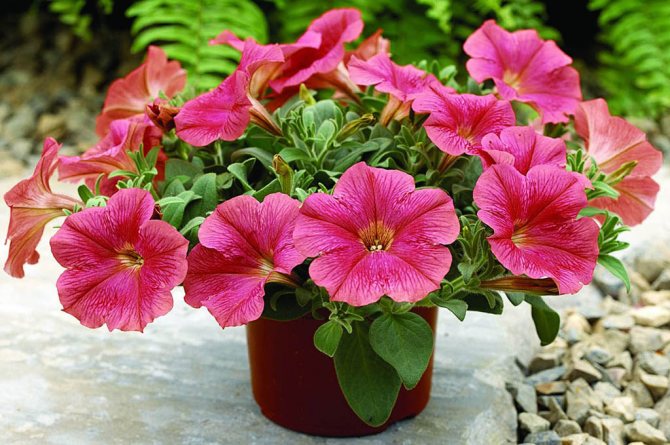

Propagation of petunias by cuttings allows you to preserve the properties of hybrid varieties
Benefits of cuttings growing
Cutting is a method of vegetative propagation of petunia, in which a cutting is separated from the mother bushes and rooted in water or soil. The advantage of this simple method lies in the complete preservation of the properties of an adult plant.
In addition to grafting, petunias are bred with seeds. This method is not very effective due to the inability to predict the landing result in advance. When planting seeds, it is impossible to influence the stages of seedling development.
Some petunias reproduce only vegetatively; these types include numerous terry varieties. These varieties make up a significant part of the petunia collections that are collected by amateur flower growers around the world.
Several parameters are usually called the advantages of cuttings:
- preservation of the characteristics of the genotype of the mother plant by cuttings from it;
- short rooting times compared to planting seeds;
- increased endurance of a plant obtained from a cuttings from a mother liquor;
- monetary savings on seeds or seedlings.
Step by step cuttings in water
How to propagate hydrangea by cuttings in spring
Shoots for cutting need to choose healthy, strengthened. The cut must be done obliquely in one motion. If the shoot is not apical, then the lower cut should be oblique, and the upper one should be flat.
Interesting fact! Lateral shoots rather than apical shoots take root better.
The cut shoot should be at least 4 cm long and have at least two nodules. The lower leaves need to be removed, the upper ones can be cut in half.
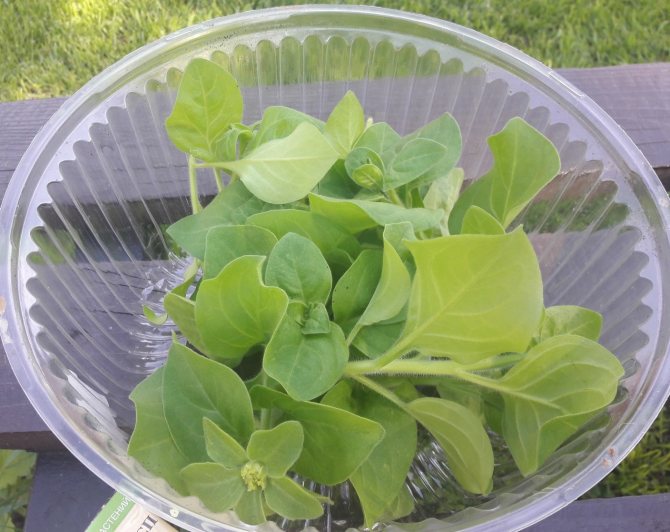

Young petunia
- Cut off shoots are placed in water for launching roots. The dishes should be opaque, preferably metal or plastic.Water needs previously settled (at least a day).
- Kornevin is added to the water, which speeds up the process of emergence of roots.
- In order to disinfect the process, one tablet of activated carbon must be diluted in water.
- When the liquid evaporates, there is no need to replace it, just add.
- The optimum temperature for cuttings in water is not lower than 20 degrees.
The first roots appear after 7 days.
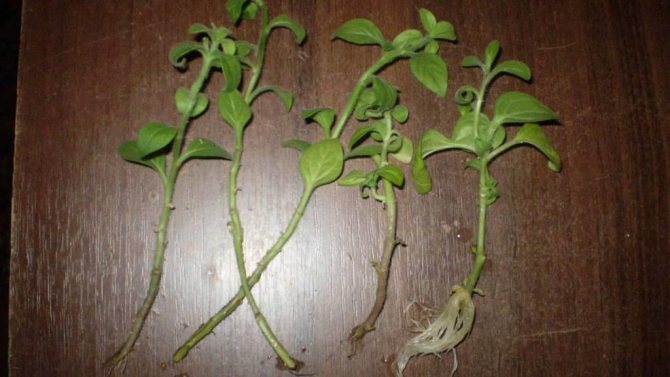

Shoots ready for rooting
When the first roots appear, the shoot is ready for rooting in loose and nutritious soil (two parts of sod land and one part of peat and sand). Rooting is fast.
After 2-3 weeks in the soil, the seedlings need to be hardened for several days in the place of their future growth. After hardening, the seedlings are ready for planting in open ground or pots.
It's important to know! Petunia seedlings should be protected from direct sunlight.
What plants to choose as mother plants?
For petunia to survive the long winter at home, the plant must be healthy. Bushes are selected that are not affected by the fungus and are free from pests.
The variety or hybrid is taken as a mother plant, it does not matter. During vegetative propagation, all the characteristics of the parent plant remain in the young flower.
- Petunia is dug out in late September-early October, after cutting off the stems (leaves 4-5 cm high).
- The flower is transplanted for the winter into a pot filled with a drainage layer and a nutrient mixture.
- For the prevention of diseases, before introducing petunias into the house, the bushes are sprayed with a solution of a fungicide and an insecticide. It can be: phytosporin, pink solution of potassium permanganate, Inta-Vir, Aktara.
- Indoors, the container is placed on a windowsill with moderate lighting.
- Keep flowers in cool rooms (constant temperature 10-15˚C).
How to root petunias directly into the soil
The stem should have two internodes and four healthy leaves. The lower leaves are removed. No more than 1/3 of the shoot length should be immersed in the soil.
How to propagate gooseberries in spring, summer and fall
For better germination, 1-1.5 cm of the lower part of the stem is treated with Kornevin. A glass prepared for seedlings should have a drainage layer and drainage holes.
Attention! The larger the pot, the more active and larger the seedling bush will be.
The soil should be loose, nutritious and not retaining moisture. The composition of the soil for petunia is two parts of sod land, one part of sand and peat. To maintain the correct level of soil moisture, vermiculite is added to the mixture. For looseness and additional respiration of the roots, perlite is added to the soil.
After placing the cuttings in the soil, cover the pot with plastic or glassware. The greenhouse effect creates an optimal moisture level for early rooting.
The pot with the shoot should be in partial shade, at a temperature not lower than 20 ° C.
Every day, the soil needs to be moistened by spraying, and the shoot should be ventilated in the open air.
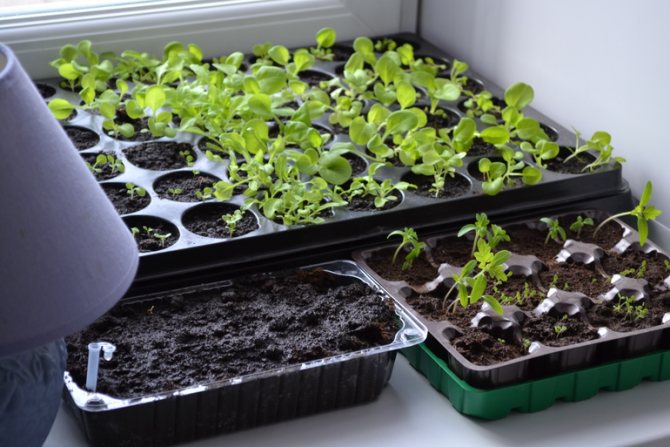

Cuttings planted in the soil
Rooting of healthy petunia cuttings occurs after 7-9 days.
With the beginning of active growth, the first pinching is done to awaken the lateral buds.
It's important to know! The petunia stalk, after two hours after cutting, loses its ability to reproduce. Immerse the cuttings in water or soil immediately after pruning. Storing cut shoots will result in unsuccessful vegetation.
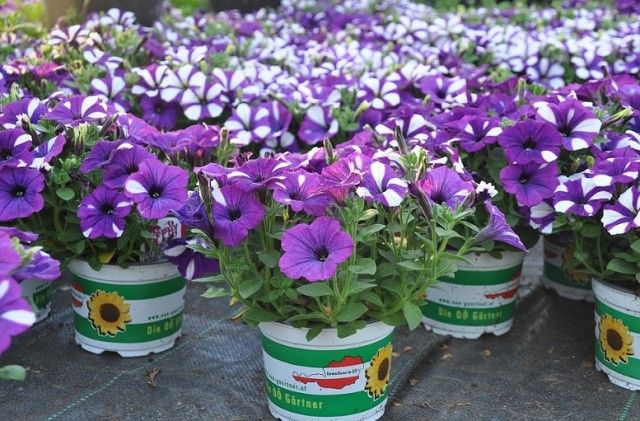

Over time, seedlings can be transferred into a larger pot, if you wait for a long time before planting in open ground or pots
Rooting methods
There are several ways to root petunias. Some require the purchase of a special substrate for planting, for others, fairly familiar materials.All options have different planting technology and are actively used by flower growers.
In the ground
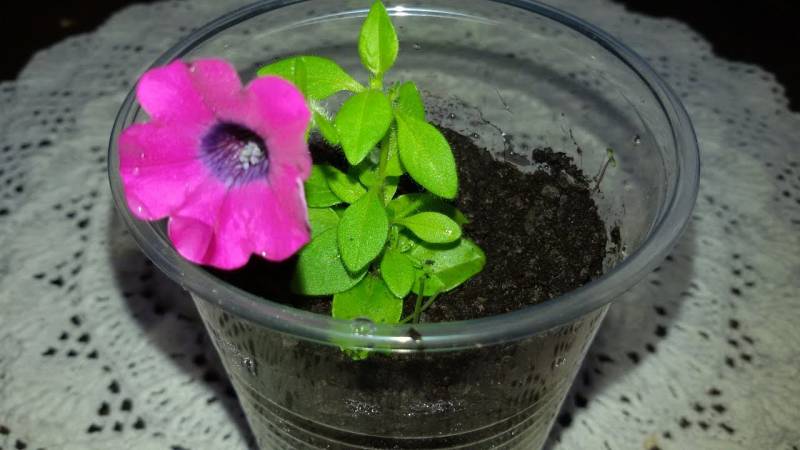

Rooting petunias in the ground is the most popular and reliable way. All varieties of this plant root well and easily tolerate a pick. With this method, the flower will not experience stress during transplantation.
For rooting, you will need a light but nutritious substrate. A versatile flower mix will do. Many gardeners prepare their own soil from peat, sand and garden soil (2: 2: 1). According to reviews, to improve the effect, it is better to replace sand with vermiculite.
Attention! In the soil mixture, soil is used taken from the place where the petunia will grow. Then the flower will easily transfer the pick to the open ground.
Be sure to use drainage: broken brick, small expanded clay, chipped ceramics.
The soil and drainage are disinfected. To do this, use one of the methods:
- poured with boiling water or a dark pink solution of potassium permanganate;
- calcined in the oven or in a frying pan;
- watered with a solution prepared from 1 tbsp. l. copper sulfate and 10 liters of water.
Peat pots, small disposable cups or cut bottles are used as containers. To create a greenhouse effect, you will need a transparent plastic bag or the upper part from a plastic bottle (it is more convenient to use it, since you just need to unscrew the lid for airing).
Step-by-step instructions for rooting petunias in the ground:
- A drainage layer is poured onto the bottom of the container. The rest of the space is filled with soil. The soil is moistened with warm water.
- The cuttings are planted in the ground, deepening by 1.5–2 cm. They should stand without support, but so that the leaves do not touch the ground.
- Cover the stalk and container with a film or a cut bottle. The resulting "greenhouse" is ventilated daily for 15 minutes.
- The seedlings are watered as the soil dries up with warm, settled water. The liquid should not get on the aerial part of the plant. After each watering, the soil is sprinkled with dry sand.
Rooting is evidenced by new leaves starting to form on the seedlings. From this moment on, the duration of the airing is increased. Soon the "greenhouse" is being dismantled.
Plants are transplanted together with an earthen clod in a larger container when the roots fill the entire space.
Attention! Some growers root cuttings in a common container. In this case, they are planted as soon as the roots are formed. The disadvantage of this method is that if one plant is damaged by a black leg, everyone will get sick.
In water
This method does not require soil preparation and a lot of time for planting. Saplings dive into separate pots immediately after the roots appear.
Rooting in water is not suitable for all varieties of petunias. There is a risk of decay of the planting material if the technology is violated.
Therefore, it is important to follow the instructions:
- Cuttings are chosen no shorter than 8 cm. As in the first case, all leaves, except for the top two, are torn off.
- The glass is filled up to half with water. A tablet of crushed activated carbon is dissolved in a liquid. This will reduce the risk of decay of the planting material.
- Place 1-2 branches in each glass. They are covered with plastic wrap or a cropped bottle and stored in a warm, dark place.
- The film is removed daily and the plant is ventilated for 15 minutes. As the water decreases, it is topped up.
When the roots appear on the seedlings, they are transplanted into individual pots, without deepening the root collar.
In vermiculite and hydrogel
In vermiculite, the cutting receives enough air, moisture and nutrients for rooting. The disembarkation takes place like this:
- Vermiculite with a fraction of 1-2 mm is poured into the container. The height of the layer should be 3-5 cm. The substrate is saturated with water, allowing the excess to drain through the drainage holes.
- The stalk is immersed in vermiculite and covered with foil. It is ventilated daily for 15 minutes. Drops of liquid are carefully removed from the film.
- When the seedling is overgrown with roots, it is transplanted into an individual container.
By the same principle, seedlings are grown in a hydrogel. Previously, the substrate is saturated with water so that it turns into wet balls. This method is not only simple, but also aesthetic.
In peat tablets
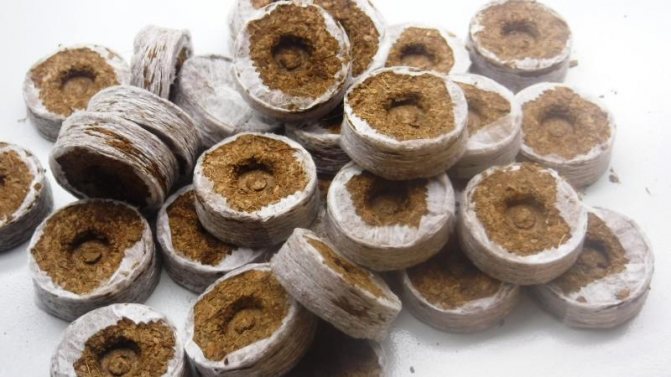

Often, flower growers use peat tablets for breeding petunias. They are filled with soil that is ideal for cultivation. One plant is planted in one tablet. The resulting bag does not have to be removed from the roots, even during transplantation.
How petunia multiplies in peat tablets:
- The tablets are put in a deep container and poured with a small amount of boiling water. As the liquid is absorbed, hot water is added. When the tablets take the form of bags, they are placed in another container (without water) and allowed to cool.
- One cuttings are planted in each tablet. The planting material is buried 2-3 cm.
- The plants are covered with foil. Air daily for 15 minutes.
- As the peat dries, it is watered. Water should not come into contact with the leaves of the seedlings.
When new leaves begin to form, the film is removed. Petunia is transplanted directly in peat bags into a large container when the root system fills the entire space.
Spring cuttings
In the summer, when the garden or veranda needs to be decorated with flowering pots, one petunia bush can be easily propagated to several dozen bushes.
How to pinch a petunia for a lush bloom
In this case, the mother plant will not be affected. This should be done during the next pinching of the petunia, before flowering, or during pruning in order to correct the shape of the bush.
It's important to know! In the spring, cuttings of petunias are carried out in order to increase the number of bushes for the current summer season. Therefore, it is necessary to propagate in the spring, taking into account that it takes about two months from the moment of the cut to the first flower.
Suitable breeding seasons
The variety of flowers can be classified according to different characteristics: by the shape of the bush, by the type of flowering and the size of the flowers, simple / double petunia. Most often, when choosing a plant for breeding, they are guided by a bush trait: ampelous, bush, cascading.
Moreover, ampelous varieties are bred year-round. Although experienced flower growers still consider August to be the optimal month for plant propagation by cuttings. Then young ampelous petunias still have time to take root well before winter. In this case, the planting material is recommended to be cut from the tops of the shoots.
Cutting petunias in spring (late February-May) is suitable for spray petunias and especially double varieties.
- When propagated in a vegetative way, petunias develop much faster. It will take about 2 months from cutting the cuttings to flowering.
- It takes 1.5-2 weeks for rooting. Consider these terms when carrying out the procedure.
Summer cuttings
Cutting petunias in summer allows you to harvest healthy and vigorous planting material. It is possible to propagate petunia by cuttings in summer, as if prolonging the life of your blooming garden, during the entire flowering period.
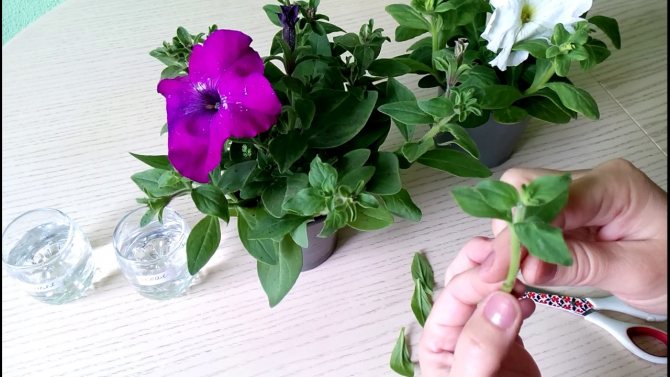

When cutting flowering shoots, the peduncle is removed
With the help of summer cuttings, you can admire the variety you like every year, extending its life through new cuttings. The most optimal propagation period for the extension of the genus of a certain variety is mid or late August.
At the end of August, petunia loses its decorative effect, so you should choose the healthiest bush, or the healthiest shoots on it. Rooting is carried out as in the case of spring cuttings. Thus, a mother plant is obtained, which will give new cuttings in winter for spring seedlings.
Vegetative petunia: basic information
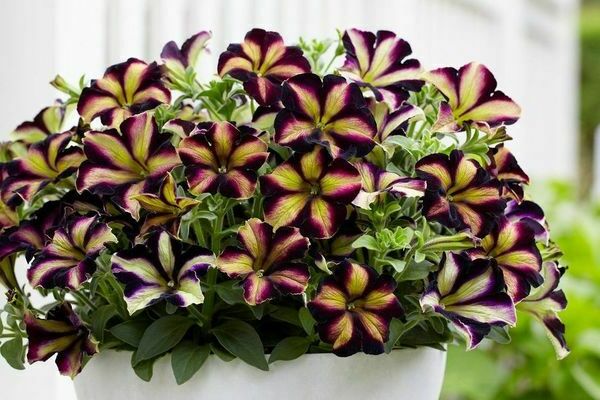

Vegetative petunia
Briefly about petunia.Florists have been fond of petunias for a very long time, there are a huge variety of them and it is very easy to choose a color and a variety that will be convenient for you according to the type of cultivation. In general, petunias are unpretentious plants and caring for them is not difficult. Petunias are often used as decorative flowers to decorate various places in the home, such as balconies or terraces. Most of the petunias reproduce using seeds, but there are also vegetative ones, in this article you will recognize them.
How to keep a mother plant
After rooting summer cuttings, the mature seedlings are transplanted into not too large pots. On an ongoing basis, young shoots should be fertilized with potash and phosphorus fertilizers. These fertilizers enable the flower to accumulate nutrients for the upcoming dormant period.
You can leave the summer plant for wintering. The bush is dug up, or transferred from the planter into a smaller pot.
The optimum temperature for wintering petunias is 16 degrees. The lower the temperature, the less light the flower requires. Watering is reduced, but without overdrying the earthen lump of the plant. Until the end of November during the dormant period, the flower does not need to be disturbed by spraying, fertilization and other procedures. Cool air, moderate lighting, and occasional watering are all he needs.
Important! It is necessary to cut off all old shoots so that the bush does not waste energy on them.
From the end of November, the plant awakening period begins. Only additional lighting with fluorescent lamps is added to the conditions of detention. The temperature remains the same. If you put the petunias in a warm place now, it will actively grow. Only the stems will be stretched out like strings and pale. Harvested cuttings from such a plant will be painful and quickly die.
The beginning of January is the awakening of the petunia. Daylight hours should be at least 16 hours. Nitrogen-containing fertilizers should be applied once every two weeks for active growth of the root system and greenery.
Features of the
Vegetative petunia is a type of plant that can be propagated exclusively by cuttings. This type of petunias includes representatives of a wide variety of varietal series. As a rule, these are ampelous varieties with double flowers. Surfiniya, tambelina - these are the most typical representatives of culture, which are actively used in the design of balconies, loggias, terraces and the local area.
Flowers of the vegetative group are quite difficult to grow from seedlings, since in most cases they immediately lose their germination, and if they do sprout, then the young petunia will be completely different from the mother. In order to quickly and easily grow a spectacular young plant, vegetative propagation methods are used.
The main botanical features of such plants include the following features.
- Vegetative varieties of petunias in the overwhelming majority of cases, it is a spreading herbaceous perennial, it is presented in a variety of forms, but usually in ampelous.
- The root system is superficial, rod type with thin lateral roots, weak branching. The roots are shallow, so care should be taken when removing weeds and loosening this plant.
- Vegetative petunia form can be erect or creeping.
- The height of the plant depends solely on the variety., usually it varies from 20 to 80 cm, however, some varieties grow much taller. For example, not so long ago, Japanese breeders bred surfinias reaching two meters. Nevertheless, it is quite difficult to achieve such a size in central Russia - under natural conditions, the maximum height of a bush does not exceed 1 meter.
- Stem - deep green, leaves and branches grow in close proximity to it. The leaf plates are densely covered with whitish villi, the color of the leaf is dark green.
- The main decoration of vegetative petunia is funnel-shaped flowers. They are velvet or simple, each consists of 5 delicate petals, tightly fused together, the edges are corrugated, wavy or straight.
Read also: How you can plant mushrooms
The color palette is very diverse - it is presented in all shades of scarlet, burgundy, pink, purple-violet and wine, as well as cream and milky white.
In most cases, vegetative petunias are grown outdoors, they look especially impressive when planted in stylish pots and hinged containers, although their cultivation in indoor conditions is possible.
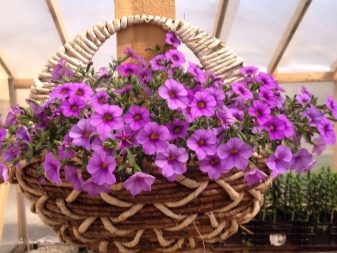

Please note that at the moment almost all varieties of ampelous petunias can be classified as vegetative. They are almost never bred by seeds, and some varieties do not form seeds at all.
Winter cuttings
A month after waking up, the bush will grow overgrown with many shoots, ready for cuttings. The period for cutting young shoots from the mother bush is February-May. It is better to root the cuttings immediately in the prepared soil. Small cut stems can be rooted in peat tablets that have been moistened beforehand.
Important! For two weeks, the planted cuttings should live in a greenhouse with daily ventilation. Every day you need to moisten the soil with a spray bottle.
When the stalk begins to grow actively, it will be ready to pinch to create more bushiness of the petunia. You need to pinch healthy, strengthened shoots, which began to actively grow up. After pinching, at least 6 leaves should remain on the seedlings. And the pinched off shoot is again suitable for rooting. Such shoots can be rooted both in water and immediately in the soil.
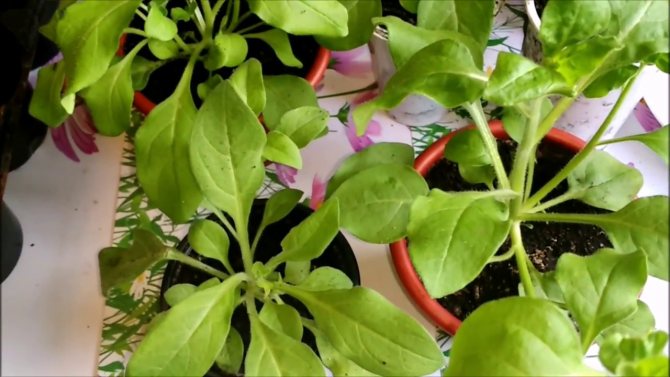

Winter seedlings are a little pale, but with the arrival of spring they will regain their rich color.
It's important to know! Terry varieties of petunias take root better immediately in the ground.
Benefits of vegetative propagation
Petunia is a perennial plant. It is in our latitudes that it is grown as an annual because of the plant's intolerance to cold weather. But if you create normal conditions for it, then from the overwintered adult bush it will be possible to cut cuttings for spring planting in the ground.
This method of reproduction has several advantages over seed:
- The plant retains all the "maternal" qualities - color, terry, bushiness, etc .;
- Blooms much earlier than seedlings grown from seeds;
- There is no need for laborious diving and thinning of small seedlings;
- When propagated by seeds, seedlings are often attacked by a black leg and die. This happens very rarely with cuttings, but they take root perfectly and do not require constant attention;
- You need to buy seeds, but you will get cuttings for free. In addition, the seeds of the desired variety may not be available for sale.
For example, we will show several photos of the most beautiful petunia hybrids in our opinion, which you can propagate with your own hands at home or in a greenhouse.
| Picture | Description |
| The flowers are pale pink, double, about 7 cm in diameter, densely cover compact bushes. Flowering begins in early June and continues continuously until September. Unpretentious. | |
| The flowers are burgundy in color, densely double, 10 cm in diameter. Compact bushes are covered with flowers that do not lose their decorative effect in rainy and windy weather. The variety is ideal for growing in pots and balcony boxes. | |
| Large salmon-colored flowers with corrugated petals look like a carnation. The bush is up to 40 cm high, strongly branched, powerful. | |
| Corrugated double flowers up to 6 cm in diameter can be pink, red, crimson, lilac, violet or purple in color. Bloom from June to September, very lush and abundant. | |
| Large-flowered variety with double flowers in various shades of pink, lavender or dark blue. The diameter reaches 13 cm, the height of the bush is 38 cm. Blooms earlier than other large-flowered petunias. | |
| A compact plant up to 30 cm high and a flower diameter up to 7 cm. Coloring - white, pink, crimson, purple, lilac monochromatic or two-color. At the same time, many flowers bloom at once. The plant is very resistant to adverse weather conditions and recovers quickly. | |
| One of the largest-flowered hybrids - the diameter reaches 15 cm. The flowers are double, with ruffled ruffled petals and a white edging, red, purple or dark pink in color. The height of the bush is 25-35 cm. | |
| Another large-flowered hybrid variety of petunia is up to 12 cm in diameter, the flowers are snow-white, densely double, bloom almost a month earlier than other varieties. Plant up to 35 cm high. |
Basic rules for the propagation of petunias by cuttings
To get quality planting material, you need to take care of the healthy growth of the mother plant long before grafting. Provide it with all the necessary conditions for active growth and flowering, as well as regularly feed it with organics and minerals.
A properly chosen cutting stalk is half the battle. If it is painful, too thin, or too short, it may take root, but a successful bush is unlikely to grow out of it.
You need to cut off the shoot with a processed tool and in one cut. When cutting, it is important to remember that the mother plant should receive the minimum amount of damage. You need to act carefully.
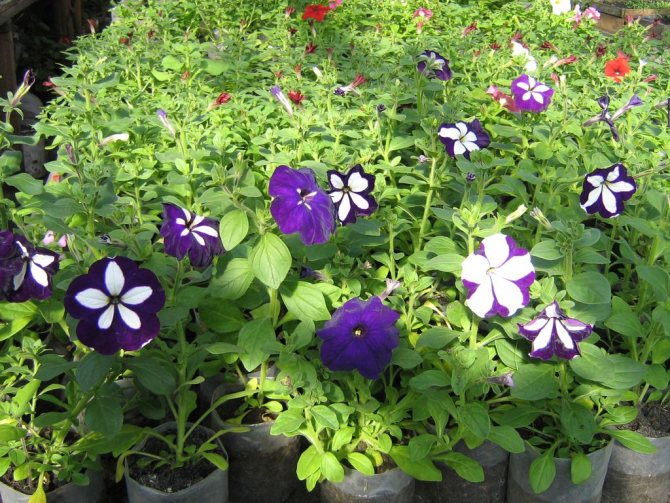

Healthy seedlings ready to be planted outdoors
The correct size of the pot will provide an active growth of the petunia root system, which means a supply of strength and nutrition for the period of active growth and adaptation after transplantation. Too small a pot for petunias can cause stunted growth and no flowering.
It's important to know! Correctly selected soil composition guarantees excellent root growth and respiration, additional feeding of seedlings, and the absence of stagnation of excess liquid. You cannot use the soil for cuttings twice.
Taking good care of your home seedlings guarantees the growth of a beautiful and healthy shrub. Moisture is created in the first weeks of rooting using a greenhouse. Moistening the soil by spraying should be carried out daily, but in moderation. The optimum temperature for seedlings is from 16 to 24 degrees. Lighting - partial shade. In winter, you need to provide seedlings with 10-hour daylight hours.
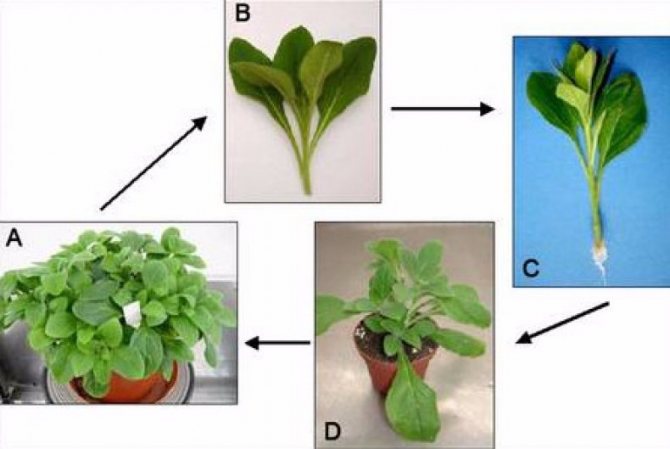

Scheme
To create a beautiful bush, it is important to pinch the upper processes in time.
Selection and preparation of cuttings
It is better to take planting material from the top of the plant. It will grow and develop faster. The branches should be bright and undamaged.
How to cut petunia:
- 6–12 cm recede from the end of the selected branch. If you take a process of greater or lesser length, it will be problematic to root it. The resulting cutting should have 4 to 6 sheets. The most powerful branches on the plant are suitable for reproduction.
- The cut is made at an angle of 45 °. The cut site is not processed.
- After receiving the planting material, they immediately begin to root it. For a day, the stalk will wither and become unusable.
Preparation for landing includes the following procedures:
- Scraps of leaves. 2 top leaves are left on the handle, the rest are removed.
- Disinfection. The material is soaked for 15 minutes in a light pink solution of potassium permanganate.
- Stimulates root formation. To do this, the seedling is soaked for a day in a solution of "Heteroauxin" prepared according to the instructions (2 tablets per 1 liter of water).
If the cuttings are not disinfected, there is a risk of contamination of other indoor plants.
Growing and vegetation of ampelous petunia
Ampel petunia is very sensitive to transplantation. Her seedlings must be planted immediately in a pot, and then placed in a flower pot.In late autumn, with the onset of stable cold weather, all shoots are cut off on the flower, which can be used for propagation at once. And you can winterize the mother plant and cut it in the spring.
Is it possible to cut petunia at home? Of course yes! This is the easiest and fastest way to grow a large number of seedlings of your favorite varieties. The vegetative propagation method allows propagation of modern hybrid varieties with a full range of their decorative qualities.
Florist reviews
Daria, 37 years old, Zaporozhye
In the spring, the neighbors gave a rooted outgrowth of my favorite terry petunia Delight. I planted it immediately in the ground. Accepted well, blooms from mid-May to cold weather. In the fall, I transplanted it into a flower basket and transferred it to the house. I overwintered perfectly, and in March I cut off the cuttings and rooted them in the ground myself. Now I'm waiting for the onset of May to transplant it to a flower bed. It is especially pleasant that in such a simple way it will be possible to enjoy the beauty every year and give scions to friends. Of the varieties with large double flowers, in my opinion, this one is the most beautiful.
Irina, 30 years old, Vladimir
Last year, in the spring, I received ten rooted cuttings of the ampel variety of petunias as a gift. Planted in the spring in a flower pot on the balcony. At first I was very worried that they would not survive, since the plants were weak and frail. I had to support them: fertilize the soil, adjust the lighting. Over time, they got accustomed, grew up and got stronger. Bloomed profusely throughout the summer. In the fall, she left to winter on a warmed loggia with ideal temperature conditions for the plant. In the spring, I cut the cuttings and rooted them in water. Unfortunately, not all processes have sprouted. For myself, I concluded that those cuttings with which I changed the water immediately died, and those which I added, as they evaporated, survived. The jar should not be transparent and a lot of water should not be poured either, because the roots are formed at the border of water and air, and too much of it can cause decay of the processes.
Rita, 35 years old, Tver region
I grow various petunias in a flowerbed in the form of a three-tiered pyramid. For decoration I use varieties and hybrids of unique beauty, among them double and large-flowered. In order to keep the color range unchanged, I propagate the most unique species by cuttings. As it turned out, this is the simplest and most financially beneficial way. For a couple of years now, I have not been looking for seeds of my favorite varieties in flower shops, but have been using my own seedlings.
Read also: How to properly fry fried eggs
What to do after the procedure
Hybrid varieties of petunias are especially demanding to maintain optimal conditions for rooting. The temperature for germinating cuttings should not be lower than +16.
Information! The first weeks there is an active growth of the root system, so changes in the development of the aboveground part of the plants are invisible.
Covering the scions with plastic wrap to create a greenhouse effect becomes unnecessary for 5-7 days.
Daylight hours for petunias should be 11-12 hours, therefore, with a lack of natural light, it is added artificially. For this, photolamps are used: they are installed at a distance of 20 centimeters from the seedlings.
Morning or evening hours are suitable for watering. The settled water at room temperature is mixed with a few drops of lemon juice.
To grow cuttings, a feeding system is provided, this allows you to make the cuttings procedure more effective:
- The first 2 weeks, the shoots are sprayed from a spray bottle with water with the addition of a potassium manganese solution.
- When leaves appear, fertilizers for the soil begin to be applied to the soil.
- For water rooting, spraying with a growth stimulant is used.
Compliance with the rules and provision of conditions for development contributes to the rapid and effective breeding of petunias.
When is the best time to propagate petunia
Specialists in the cultivation of flower crops consider one of the main advantages of the agrotechnical characteristics of petunias - the ability to carry out cuttings at any time of the year. This allows you to breed a diseased or damaged plant without waiting for the optimal time.
If there is no urgent need to engage in cuttings, then the period from February to May is chosen for it.
Summer cuttings
Breeding petunias in summer has several advantages:
- the presence of natural light by increasing daylight hours;
- optimal temperature conditions.
Petunia care in winter
The plant is looked after in the same way as in the open field. The flower is placed on the east window, providing supplementary lighting in the darkest days of winter.
Watering petunias is necessary regularly, but excess moisture should not be allowed. It is especially important not to overflow the plant if the room temperature is kept at 18 degrees. Water for irrigation should be at room temperature. It is useful to use melt water for irrigation. As a measure to prevent the appearance of rot, watering with clean water is alternated with watering with a pink solution of potassium permanganate.
Fertilizing with mineral fertilizers for flowers (Kemira, Fertika) is applied every 2 weeks only in pots with flowering bushes. Non-flowering plants do not feed. Preference should be given to phosphorus-potassium fertilizers.
What to do in case of errors
Despite the fact that petunia is considered the most suitable flower for cuttings, growers often make mistakes that prevent the growth and development of the shoot. The first sign of a problem is that the stalk is not rooting. To understand the reason, it is necessary to assess the general condition of the planting.
| Characteristic | Error symptom | Prevention and elimination measures |
| Temperature regime | The appearance of condensation on the walls of the glass, the accumulation of moisture on the leaves of the appendix | Airing the landings for 10-15 minutes daily, observing the optimal regime: it should not exceed +22 ° |
| Air humidity | Condensation build-up or leaf curling. The appearance of spots on the leaves | Regular ventilation, water addition during evaporation |
| The soil | Solid dry soil | Gentle watering, systematic loosening of the soil around the cutting |
| Watering conditions | Dry soil or too moist soil | Watering at the root or regularly replenishing water by evaporation |
| The location of the processes | The shoot lies on the ground, has a stunted, sick appearance | Overflow possible, beginning of root decay |
If the shoot does not take root in the water, rot appears on the cut surface, then the procedure should be repeated. To do this, the process is taken out, the cut is washed, treated with activated carbon. The water is drained, then a fresh portion is poured with the addition of a manganese solution for disinfection.

